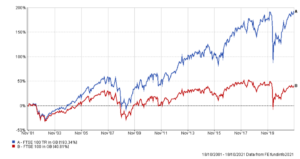
As 2021 draws to a close, investors can look back on a year that still presented challenges, despite conditions being much more benign than those experienced a year earlier. Following the very sharp recession seen at the start of the pandemic, we have witnessed a broad based economic recovery, fuelled by continued economic support from central banks and governments, which has continued to provide markets with the confidence to move forward.
At the time of writing, the S&P500 index of US shares stands 27% higher than at the start of the year, whereas the FTSE100 stands 12% higher. These increases have built on the strong returns seen during the latter part of 2020. Whilst most investment markets are higher than at the start of the year, there have been areas to avoid. Chinese markets, weighed down by concerns over the debt-laden property sector and government policy, have fallen throughout the year, despite a modest recovery seen over recent weeks. The safest government bonds have also seen disappointing returns, as inflationary pressures bite.
Compared to the wild swings in sentiment seen during 2020, this year has seen more stable conditions for investment markets. Apart from some volatility around the time that the Omicron variant was discovered, investment markets have sailed through much calmer waters than was the case a year ago.
As we progressed through the year, investor attention began to shift away from the pandemic, and the increasing rate of inflation being seen in Western economies became the primary concern. In the UK, the Consumer Price Index hit 5.1% in the 12 months to November 2021, the highest level for a decade. We are not alone in facing higher inflation, with the prevailing rate in the US standing just short of 7% per annum. A number of factors have contributed to the increase in inflation – demand for goods such as building materials and microchips has outstripped supplies, and the cost of shipping goods has also risen sharply. We have all felt the impact of higher gas and electricity prices, and food prices also continue to rise. Spare capacity in the labour market may also lead to modest levels of wage inflation, as certain sectors, such as hospitality and logistics, struggle to hire employees.
The heightened rate of inflation is unlikely to be welcome news for many. Whilst higher rates of inflation are helpful in eroding levels of debt, for households struggling with increasing energy costs, and for those individuals holding cash savings, these are painful times. Central banks would ordinarily be looking to increase interest rates at this point in the economic cycle, to combat the higher rates of inflation. However, they need to tread carefully to avoid damaging the fragile economic recovery. Taking away the support and raising rates too quickly could reverse the economic gains achieved since the height of the pandemic, whereas leaving rates on hold for too long could stoke inflationary pressure further.
The Bank of England was the first to jump, raising rates from 0.10% to 0.25% this month, and we expect most Western central banks to continue raising rates during the course of 2022. The pace of these rate increases is likely to be a key factor in determining how markets perform during the course of the year, and clear forward guidance – such as we are seeing now from the Federal Reserve – will be needed to avoid markets being spooked by unexpected changes in policy.
So where do markets go in 2022, and what is in store for the coming year? Firstly, the emergence of Omicron reminds us that sadly the pandemic is not over. Investors have faced continued uncertainty in the face of the virus since March 2020, and it is becoming clear that Covid-19, and the actions taken by governments to combat the spread, is once again going to dominate market sentiment as we head through into the New Year. As we have seen over recent weeks, governments around the world appear to be keen to avoid the kind of restrictions that could deal a substantial blow to the economic recovery, but they need to balance this with the need to protect public health.
The actions of central banks will also likely have an influence on market confidence. The rapid rise in inflation may well remain a headache for policymakers throughout next year, and tough decisions on removing key support that has been in place since the start of the pandemic could have negative consequences. Inflation may well start to moderate as we move through the next 12 months, although we suspect prevailing inflation rates will stay a little higher for longer, placing further pressure on central banks and savers.
We will be watching corporate earnings closely as we move through into 2022. By and large, profits have held up well and in some sectors have exceeded expectations this year. We do, however, need to be mindful that the valuations of some sectors of the economy are now looking a little expensive.
Finally, in contrast to the calm conditions we have seen through this year, we may well see a little more volatility return as a result of Omicron and the key interest rate policy decisions that will need to be taken. For this reason, 2022 could well be a year when paying careful attention to asset allocation, and maintaining good levels of diversification, are crucial to navigate the prevailing conditions successfully. Rest assured we are here to provide guidance and reassurance whenever needed.
If you are interested in discussing the above with one of the experienced financial planners at FAS, please get in touch here.
May we take this opportunity to wish you a peaceful, happy Christmas with good health and prosperity in 2022!
This content is for information purposes only. It does not constitute tax planning or financial advice.














